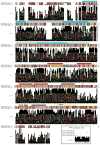What do we know about the transient receptor potential vanilloid 2 (TRPV2) ion channel?
- PMID: 23615321
- PMCID: PMC3783526
- DOI: 10.1111/febs.12302
What do we know about the transient receptor potential vanilloid 2 (TRPV2) ion channel?
Abstract
Transient receptor potential (TRP) ion channels are emerging as a new set of membrane proteins involved in a vast array of cellular processes and regulated by a large number of physical and chemical stimuli, which involves them with sensory cell physiology. The vanilloid TRP subfamily (TRPV) named after the vanilloid receptor 1 (TRPV1) consists of six members, and at least four of them (TRPV1-TRPV4) have been related to thermal sensation. One of the least characterized members of the TRP subfamily is TRPV2. Although initially characterized as a noxious heat sensor, TRPV2 now seems to have little to do with temperature sensing but a much more complex physiological profile. Here we review the available information and research progress on the structure, physiology and pharmacology of TRPV2 in an attempt to shed some light on the physiological and pharmacological deorphanization of TRPV2.
Keywords: TRPV2; calcium signalling; cancer; endocrinology; immunology; ion channels; muscle physiology; neuroscience; pharmacology; somatosensation.
© 2013 FEBS.
Figures



Similar articles
-
TRPV2: a universal regulator in cellular physiology with a yet poorly defined thermosensitivity.J Physiol Sci. 2024 Sep 16;74(1):42. doi: 10.1186/s12576-024-00936-1. J Physiol Sci. 2024. PMID: 39285320 Free PMC article. Review.
-
TRPV2.Handb Exp Pharmacol. 2014;222:247-72. doi: 10.1007/978-3-642-54215-2_10. Handb Exp Pharmacol. 2014. PMID: 24756709 Review.
-
Expression and distribution of three transient receptor potential vanilloid(TRPV) channel proteins in human odontoblast-like cells.J Mol Histol. 2017 Dec;48(5-6):367-377. doi: 10.1007/s10735-017-9735-2. Epub 2017 Sep 13. J Mol Histol. 2017. PMID: 28905239
-
Targeting TRPV1 and TRPV2 for potential therapeutic interventions in cardiovascular disease.Transl Res. 2013 Jun;161(6):469-76. doi: 10.1016/j.trsl.2013.02.003. Epub 2013 Feb 27. Transl Res. 2013. PMID: 23453732 Review.
-
Vanilloid transient receptor potential cation channels: an overview.Curr Pharm Des. 2008;14(1):18-31. doi: 10.2174/138161208783330763. Curr Pharm Des. 2008. PMID: 18220815 Review.
Cited by
-
Induction of therapeutic hypothermia by pharmacological modulation of temperature-sensitive TRP channels: theoretical framework and practical considerations.Temperature (Austin). 2015 Apr 27;2(2):244-57. doi: 10.1080/23328940.2015.1024383. eCollection 2015 Apr-Jun. Temperature (Austin). 2015. PMID: 27227027 Free PMC article. Review.
-
Polymodal Transient Receptor Potential Vanilloid (TRPV) Ion Channels in Chondrogenic Cells.Int J Mol Sci. 2015 Aug 7;16(8):18412-38. doi: 10.3390/ijms160818412. Int J Mol Sci. 2015. PMID: 26262612 Free PMC article.
-
Evaluation of cationic channel TRPV2 as a novel biomarker and therapeutic target in Leukemia-Implications concerning the resolution of pulmonary inflammation.Sci Rep. 2019 Feb 7;9(1):1554. doi: 10.1038/s41598-018-37469-8. Sci Rep. 2019. PMID: 30733502 Free PMC article.
-
Cancer Stem Cells of Esophageal Adenocarcinoma are Suppressed by Inhibitors of TRPV2 and SLC12A2.Ann Surg Oncol. 2023 Dec;30(13):8743-8754. doi: 10.1245/s10434-023-14247-z. Epub 2023 Sep 8. Ann Surg Oncol. 2023. PMID: 37684371
-
Loss of TRPV2 Homeostatic Control of Cell Proliferation Drives Tumor Progression.Cells. 2014 Feb 19;3(1):112-28. doi: 10.3390/cells3010112. Cells. 2014. PMID: 24709905 Free PMC article.
References
Publication types
MeSH terms
Substances
Grants and funding
LinkOut - more resources
Full Text Sources
Other Literature Sources

